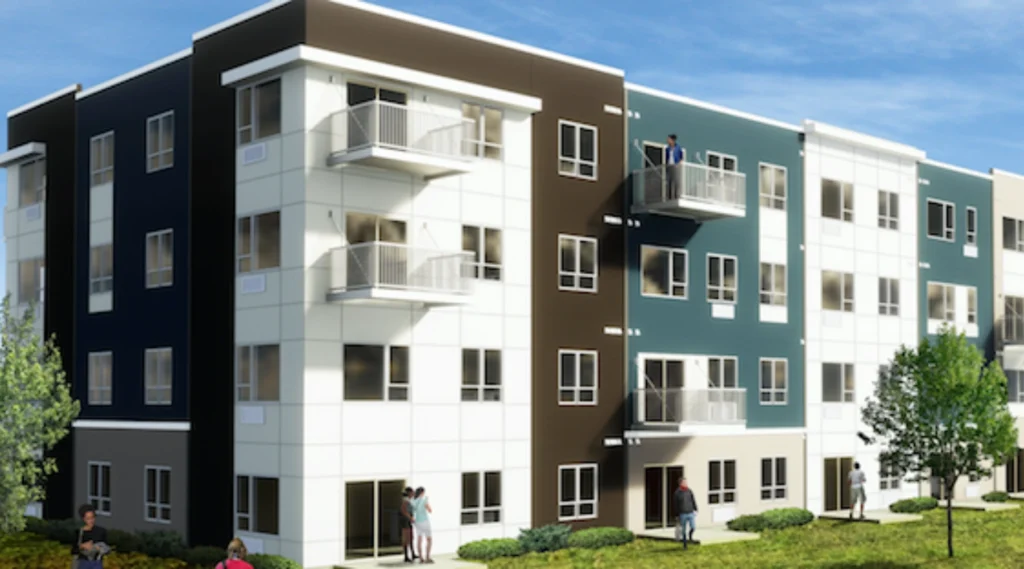CARMEL, IN (Dec. 27, 2018) – Mortgage banking firm Merchants Capital has secured financing for the development of a $19.7 million mixed-income workforce housing community in Rochester, Minnesota. Merchants Capital secured the loan through the first-ever Freddie Mac Non-LIHTC Forward Commitment on behalf of Real Estate Equities.
Dubbed Technology Park Apartments, the 164-unit affordable housing complex will help to ease the city’s affordable housing crisis, as Rochester was recently ranked one of the lowest metropolitan statistical areas (MSAs) nationally for housing affordability by Nationwide Economics. The project closed on Sept. 5, 2018.
“We appreciate the opportunity to assist in the development of this housing community and the chance to help close Rochester’s affordable housing gap,” said Michael R. Dury, president of Merchants Capital. “We were able to simplify the process with our ability to provide the construction financing through our parent company, Merchants Bank, and also offer the Freddie Mac Non-LIHTC Forward Commitment product for the long term permanent financing.”
The apartments were financed through a 10-year Freddie Mac Non-LIHTC Forward Commitment loan where the interest rate was locked at the closing of the construction loan. Non-LIHTC forwards are unfunded, forward commitments for affordable housing developed by nonprofits and subsidized, rent-restricted affordable housing that for-profit developers can use for their new multifamily construction or substantial rehabilitation projects.
“We are very excited to be on the forefront of developing a modern workforce housing product that is not heavily reliant on government funding sources,” said Alexander Bisanz, director of acquisitions at Real Estate Equities. “Partnering with the Greater Minnesota Housing Fund to provide low-cost, mission-driven equity – as well as structuring attractive financing with Merchants Capital – truly allowed us to get this project off the ground.”
Forty percent of Technology Park Apartments will be priced affordably for individuals earning an annual income of $40,000, or 60 percent of the area’s annual median income (AMI). The Greater Minnesota Housing Fund contributed a total of $3.4 million in capital for the development of these units, which will cost renters an estimated $1,150 a month for a two-bedroom apartment.
An additional 35 percent of units will be set aside for individuals earning about $55,000 a year, 20 percent below Rochester’s AMI. The remaining units will be priced slightly below the current market value, about $200-300 less than similar apartments in the area.
“In all of Greater Minnesota Housing Fund’s work to create and preserve unsubsidized affordable housing, we have struggled to crack the code on the production of new affordable units without reliance on public resources. Now, as an equity partner in Technology Park, we are furthering our mission and innovating ways to increase the funding pie with new financing solutions,” said Rachel Robinson, fund manager with Greater Minnesota Housing Fund. “Going forward, Tech Park, with 164 modestly priced apartments, 66 at reduced, affordable rents, will be a pilot for further innovation in this realm.”
Technology Park’s cost-efficient, smart building design achieves sufficient economies of scale to charge modest rents, meeting the needs of a range of household incomes. Today’s market financing tools are working best for luxury apartment construction, and at the other end of the spectrum, affordable apartment developments financed with federal tax credits are limited in supply. Developers have struggled to find ways to finance new construction homes that are in between: achieving modest rents for residents without government subsidy. Freddie Mac’s new Non-LIHTC Forward Commitment achieves this.
“Freddie Mac’s forward commitment is helping to provide affordable housing for valued members of the Rochester, Minnesota, community who struggle to find it,” said David Leopold, vice president of targeted affordable sales & investments at Freddie Mac Multifamily. “We created Non-LIHTC Forwards for this very purpose – to provide the flexibility and certainty mission-driven investors need to finance housing for low- and very-low income families.”
Technology Park Apartments will be located in Rochester, Minnesota, on the north side of Technology Drive Northwest between Valleyhigh Drive and West Circle Drive. Neighboring Benchmark Electronics to the east, Costco to the south and Crooked Pint to the west, the complex is positioned in close proximity to grocery stores and other nearby amenities.
Read More



